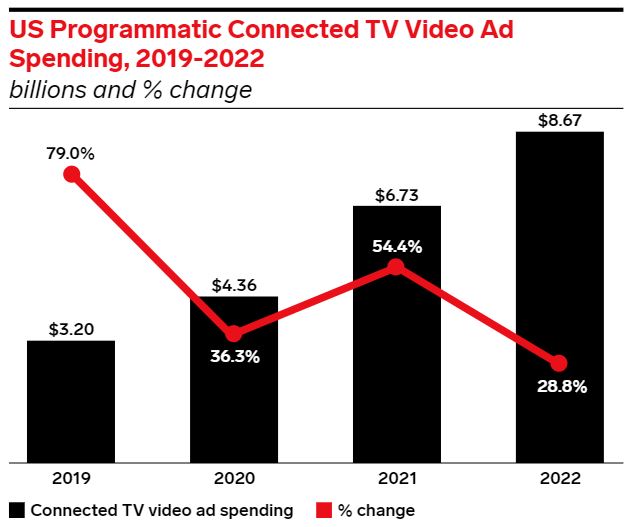The Difference Between CTV and OTT Ads
April 13, 2021
TV content market is going through transformations, caused largely by a rapid shift towards new methods of content delivery. Consumers around the globe are increasingly “cutting the cord” and giving up cable, satellite and broadcast TV in favor of CTV and OTT.
CTV/OTT ads spending is on the rise
Following the audience, the TV advertising market also goes through this shift. The share of CTV and OTT ads in the overall advertising spending is rising year after year. According to eMarketer’s Q3 2020 Digital Video Trends report, CTV advertising in the US has increased 25% in 2020. With ad-supported video-on-demand (AVOD) revenue up 31% and digital upfront TV ad spend up 11%, despite the downturn in traditional TV advertising.
As consuming TV content via CTV and OTT increasingly becomes the new normal, analysts expect that in 2021 CTV and OTT ads will be “the breakout star” of the advertising market. An increasingly large number of businesses are starting to realize all the benefits and potential of these platforms.
“We found that while CTV/OTT spend has increased, there is a significant opportunity for advertisers to include these channels in their marketing mix. Fewer than 40% of advertisers have spent on CTV/OTT channels in the past year, significantly lagging behind social media, display, and non-CTV/OTT video,” eMarketer reports. Analysts also added that forecasts for spending on OTT/CTV in Q4 2020 and H1 2021 look very promising, with 22% of advertisers planning to significantly increase YoY spending in 2021.
If you are not as well versed on the fundamental pros and cons of CTV and OTT platforms, be sure to read up about it in this detailed article.

eMarketer chart showing the change in Programmatic CTV Ad Spend from 2019-2022
CTV vs. OTT. What’s the difference?
As a fairly new trend in advertising, CTV and OTT are still relatively unknown. The differences and distinctive features of these platforms are not obvious to the majority of people unfamiliar with these technologies. This is why we decided to compare the two platforms’ advertising with each other and specify the differences between these two advertising platforms.
Knowing the differences between the two is important as when it comes to advertising, they both have strengths and limitations, so utilising them properly to complete one another is the key to success.
But first, let’s make sure that we all are on the same page here in terms of names and abbreviations. CTV stands for Connected TV, which is a term for connected streaming devices such as Apple TV, Roku or Chromecast. And OTT (over-the-top) is a term for media services such as Netflix, Amazon Prime, Disney Plus, etc.
-
Audience immersion / skippability
CTV: ads are more immersive for the audience as they can’t be skipped.
OTT: ads are less immersive as they can be skipped.
One of the key differences between CTV and OTT advertising formats is the fact that most CTV ads are unskippable. Most OTT platforms allow users to skip the ads. This gives CTV advertising a clear edge over OTT in terms of audience engagement. This feature definitely should be considered when planning an advertising campaign.
-
Audience engagement / clickability
CTV: ads are not clickable, which makes them less engaging.
OTT: ads are clickable, which makes them more engaging.
The other notable difference dividing these two related to each other formats is clickability of the ads. As CTV are generally unclickable, even though they can’t be skipped, it makes them less engaging for the audience. OTT ads are clickable, which allows advertisers to attract leads to their websites with great conversion results. The two differences highlighted above can also be viewed as a strength of CTV&OTT advertising in general. Each having its unique strengths, both advertising formats allow businesses to design their marketing campaigns in a way to get the maximum benefit out of both formats.
-
Audience reach
CTV: can only reach audiences with CTV television sets.
OTT: can reach viewers using computers, laptops and smartphones.
OTT ads have another notable difference when compared to CTV. Unlike CTV ads that are only shown when viewing content on CTV devices, OTT reaches a large audience who view content via their laptops and mobile devices.
-
Costs / CPM
CTV: costs are slightly higher than OTT ads but still much lower than other TV advertising formats.
OTT: OTT ads cost lower than CTV and other major TV advertising formats.
OTT ads are generally more affordable, but both ads can be considered affordable compared to the costs of cable and linear TV advertising. Also, OTT offers less expensive web viewership on mobile devices and computers.
-
Targeting and measurability
CTV: offers advertisers advanced targeting, enhanced audience analysis and measurement.
OTT: also offers digital targeting and measurability tools, but with less accuracy and more frequent ad fraud.
When it comes to targeting and measurability, both CTV and OTT have a lot to offer when comparing them to traditional TV advertising. Due to its hardware, CTV has more to offer in targetability, offering advertisers advanced targeting, dynamic ad insertion and rich audience analysis and measurement. OTT advertising tends to compensate for less advanced targeting and measurability with lower costs and larger audience coverage.
-
Ad fraud
CTV: has lower levels of fraud compared to other digital environments.
OTT: has a higher level of fraud compared to CTV (but lower CPM).
Rise of CTV & OTT advertising also brought the attention of fraudsters to these platforms. Ahead of 2020, 46% of publishers cited ad fraud as a challenge for programmatic advertising, well above the 38% of respondents industry-wide who said increasing levels of ad fraud would be a concern for automated transactions, according to The Industry Pulse Report.
Even though both CTV and OTT tend to suffer from ad fraud, some research shows that CTV advertising has less of it. Integral Ad Science verified hundreds of millions of ads and saw lower levels of fraud in CTV compared to other digital environments.
Conclusion
As you can see, although CTV and OTT are very similar and directly related to each other advertising formats, they do have a number of considerable differences. Understanding all the features and characteristics of these hot new ad technologies is the first step to get real business benefits from using them as part of your marketing efforts.
CTV and OTT ads can serve as a powerful tool providing advertisers previously unseen targeting features and audience reach.
We’d love to hear from you! Get in touch today to see how pubGENIUS can increase your site’s revenues!
